The Allure of Polished Geodes: A Comprehensive Exploration
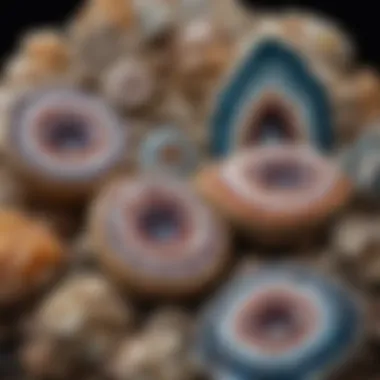
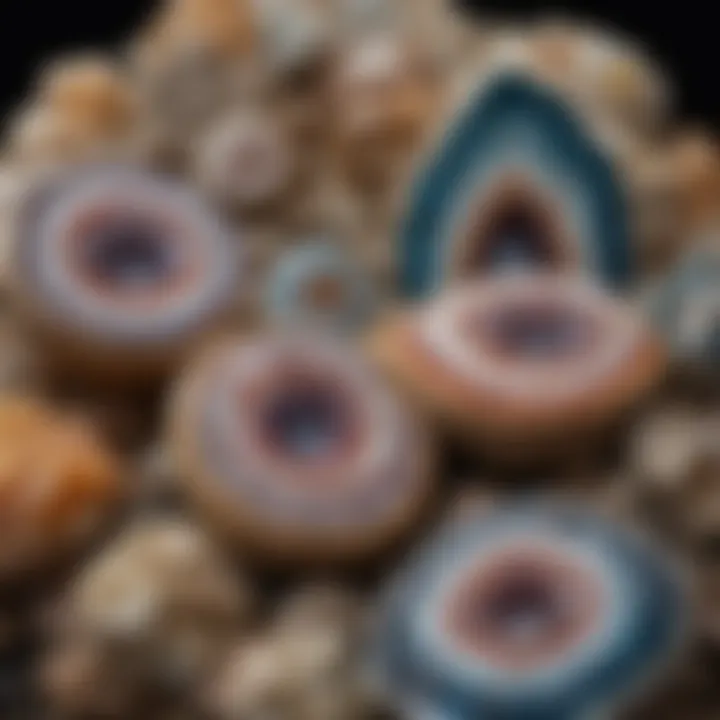
Intro
Polished geodes have always held a unique place in the hearts and collections of mineral enthusiasts and rock lovers alike. These natural wonders are not just beautiful; they also tell compelling stories of the Earth's geological processes, captivating anyone who takes the time to delve into their origins. From the turbulent forces that shape their formation to the intricate details revealed during cutting and polishing, geodes offer a window into the planet’s hidden treasures.
In the realm of collecting, geodes serve both aesthetic and historical value, making them sought-after items for those who appreciate the artistry of nature. This exploration seeks to dissect the multifaceted characteristics and significance of polished geodes, paving the path for collectors who wish to deepen their appreciation.
Featured Collectible of the Month
Overview
This month, our spotlight shines on the stunning amethyst geode, a true gem in the world of mineral collecting. Famous for their rich purple hues and mesmerizing crystal formations, amethyst geodes are more than just display pieces—they represent the allure of natural beauty transformed through geological processes.
These geodes typically form within volcanic rock, where once molten materials and gases create unique cavities. Over time, minerals from surrounding fluids crystallize inside these openings, leading to breathtaking clusters of amethyst crystals.
Historical Significance
Amethyst has a storied past, intertwined with various cultures and beliefs. In ancient Egypt, it was regarded as a stone of protection, thought to ward off evil spirits. Similarly, Romans valued it highly, often associating it with status and power. Even today, its significance endures, captivating both collectors and spiritual practitioners.
"The brilliance of amethyst was so revered that it was believed to be a gift from the Earth itself."
Collecting amethyst geodes allows enthusiasts not just to own a piece of art but also to connect with the various narratives that shaped its legacy through the ages. Today’s collectors appreciate not only the beauty of these geodes but also their rich history, connecting the past with the present.
Identification Techniques
Visual Characteristics
Identifying polished geodes, particularly amethyst ones, involves an eye for both detail and texture. Here are some key attributes to observe:
- Coloration: A vibrant purple indicates high-quality amethyst, while a more muted tone may suggest a lesser grade.
- Crystal Formation: Look for well-defined crystals that exhibit symmetry and sharpness. Clear, transparent crystals are often more desirable.
- Exterior Texture: The outer surface should display a rough, lava-like texture unless polished.
Resources for Identification
For collectors eager to hone their identification skills, several resources can provide valuable insights. Some recommended platforms include:
- Wikipedia: Geode
- Britannica: Amethyst
- Reddit: Engaging in community discussions about geodes can provide personal anecdotes and experiences.
- Facebook: Various groups dedicated to geode collecting often share tips and tricks for both identification and care.
Incorporating these techniques and resources enables collectors to make informed decisions about the geodes they acquire, enhancing their collection’s overall quality and value.
Understanding Geodes
Geodes are fascinating natural formations that stir both scientific interest and aesthetic appreciation. Understanding geodes is a crucial step in exploring their allure, especially for enthusiasts and collectors. These hollow rocks, often lined with crystals, tell a story of geological processes that span millions of years.
Getting to know geodes helps collectors make informed decisions when it comes to purchasing, displaying, or even negotiating their value. They come in multiple varieties, each presenting a different combination of internal structures, colors, and mineral compositions. This variety not only enhances the visual appeal but also the depth of appreciation for the geological craftsmanship involved in their formation.
Moreover, awareness of the unique characteristics of geodes can help collectors recognize what makes a certain specimen more sought after. Such knowledge can guide both novice and experienced collectors in identifying quality pieces that will enrich their collections without breaking the bank.
Definition of Geodes
At its core, a geode is a rock formation that appears ordinary on the outside but houses a spectacular interior. These hollow cavities are usually lined with minerals and crystals, often leading to a striking visual difference between the exterior and the interior. They can vary widely in size, from tiny nodules to large boulders, and their outward appearance can range from nondescript to quite intriguing. Often, the best way to identify a geode is by its rounded shape and a somewhat rough texture, indicating hidden treasures within.
Formation Processes
Geodes arise through various formation processes, each contributing uniquely to their charm:
Vapor Deposition
Vapor deposition involves the mineral constituents in vapor form settling within cavities or voids in rocks. Over time, these minerals crystallize, giving rise to beautiful interiors. This process results in fine, often delicate crystals, which can be quite striking and desirable for collectors. Furthermore, the unique formation conditions can lead to intricate designs within the crystal structure, making each geode a veritable treasure trove of natural art. However, this method requires a very specific set of environmental conditions, which can be limiting.
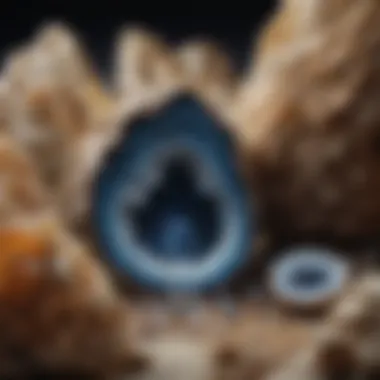
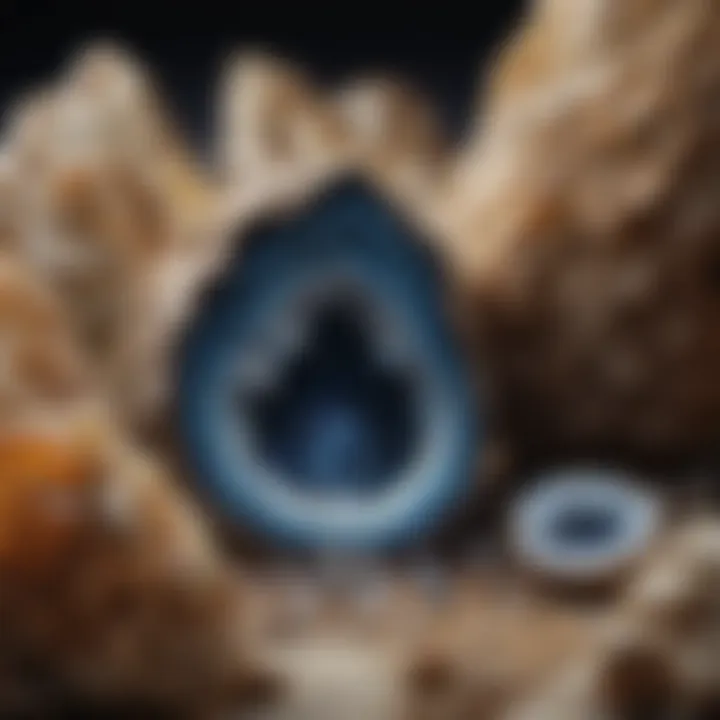
Hydrothermal Processes
Another fascinating formation avenue is hydrothermal processes, where hot, mineral-rich fluids seep into cracks and cavities within rocks. As these fluids cool down, they deposit their minerals in fantastic shapes and striking colors. Hydrothermal geodes are known for their vibrant colors and well-defined crystal structures, often featuring quartz or other silica compounds. However, while these geodes offer aesthetic appeal, they can sometimes be more expensive due to the intricacies of their formation; availability may also vary, depending on geological activity.
Sedimentary Environments
Finally, geodes can form in sedimentary environments where minerals precipitate out of groundwater, filling voids in limestone or sandstone over long periods. This formation process can lead to a wide variety of minerals lining the interior. With sedimentary geodes, expect bold hues and creative patterns. They often come at a lower price point, which can be a plus for those just starting their collection. However, the interior designs may not be as intricate as those found in vapor-deposited or hydrothermally formed geodes.
Unique Characteristics
What makes geodes particularly captivating is their unique characteristics:
Internal Structures
The internal structures of geodes can feature intricate arrangements of crystals, various shapes, and different mineral compositions. These structures tell stories of their formation environment, making each piece unique. Notably, the way crystals develop inside a geode can lead to formations that look entirely different from one another, even if they originate from the same location. As such, examining these formations can be a rewarding and enriching endeavor for any collector.
Type of Minerals
The type of minerals found within geodes, such as quartz, calcite, or amethyst, greatly affects their value and desirability. Some minerals are rarer than others, which can mean more vibrantly colored or complex crystal structures. Being knowledgeable about these minerals helps collectors identify quality pieces and understand their potential for display or investment.
Color Variations
Color variations in geodes can run the gamut from deep purples of amethyst to the soft blues of celestite. These color differences not only enhance the visual appeal but also signify the underlying mineral composition. Knowledge of color variations helps collectors in their search; for instance, collector's items like blue celestite geodes can command higher prices due to their rarity and beauty.
"Geodes exemplify nature's artistry—a rough exterior hiding a world of inner beauty."
Understanding geodes, therefore, enriches one’s collecting experience. With insights into their definitions, formation processes, and unique characteristics, collectors can engage more deeply with these geological marvels.
Types of Geodes
Understanding the different types of geodes is crucial for collectors and enthusiasts, as each type has its own unique features, value, and appeal. These variations not only showcase the diversity of geodes but also provide insight into geological processes. From vibrant colors to intricate crystal formations, the types of geodes can greatly influence a collector’s choices and preferences. By familiarizing oneself with these distinctions, one can enhance their collection and appreciation for these fascinating geological formations.
Quartz Geodes
Quartz geodes are perhaps the most well-known variety. They typically form in volcanic ash beds or sedimentary rocks, where silica-rich solutions create beautiful crystal structures. These geodes often showcase a clear, glassy texture that many collectors find appealing. The sparkle of quartz crystals can add a touch of elegance to any collection. Their abundant presence makes them relatively accessible, yet they can still be stunning. Moreover, quartz is believed to have metaphysical properties, enhancing its desirability among various collectors.
Amethyst Geodes
If you’re looking for something with a touch more color, then amethyst geodes might catch your eye. With their signature purple hues, they are often seen as a symbol of spirituality and calmness. Found predominantly in volcanic regions, these geodes can house large caverns filled with amethyst crystals. The depth of color can vary, from pale lilac to rich, dark purple. This variety is highly sought after for both its beauty and supposed healing properties. Owning an amethyst geode is not merely a matter of aesthetics; it can also hold a place of importance in wellness practices.
Calcite Geodes
Calcite geodes, while maybe not as flashy as quartz or amethyst, bring their own charm to the table. They are typically found in limestone deposits and reveal a range of shapes and sizes. The crystals found within these geodes can be clear, white, or even colored, depending on impurities present during formation. Calcite is known for its fascinating optical properties, especially when it comes to light refraction. Owning calcite geodes can be particularly valuable as they often serve as educational tools for understanding geological processes.
Other Notable Types
Agate Geodes
Agate geodes are widely appreciated for their intricate banding and colorful patterns. Often formed from the same silica-rich solutions, the beauty of agate lies in its layered appearance. Each slice can reveal a natural masterpiece, with swirls of color that can captivate any observer. Many collectors enjoy agate geodes due to their affordability and accessibility, making them a popular choice in the world of geode collecting. The unique aspect of agate is its capability to be polished, revealing stunning details within. However, while agate is popular, it might not command the same prices as more rare types like amethyst.
Opal Geodes
Opal geodes present an entirely different challenge. Known for their play-of-color, opal is revered for its optical effect that can be mesmerizing to witness. These geodes can be less common and more difficult to source, which can make them a tantalizing find for serious collectors. The unique feature of opal geodes is the way they can reflect light in almost rainbow-like patterns. Though they might be on the pricier side, the beauty and rarity often justify their inclusion in a high-quality collection. Collectors must be careful, however, as opals can be more fragile compared to other types of geodes, necessitating special care and handling.
The variety of geodes not only reflects the geological history of the Earth but also adds to the personal stories of collectors, each piece holding its own significance.
The Process of Polishing Geodes
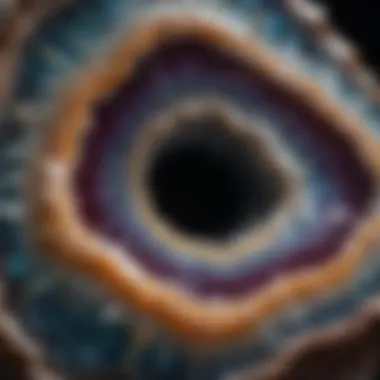
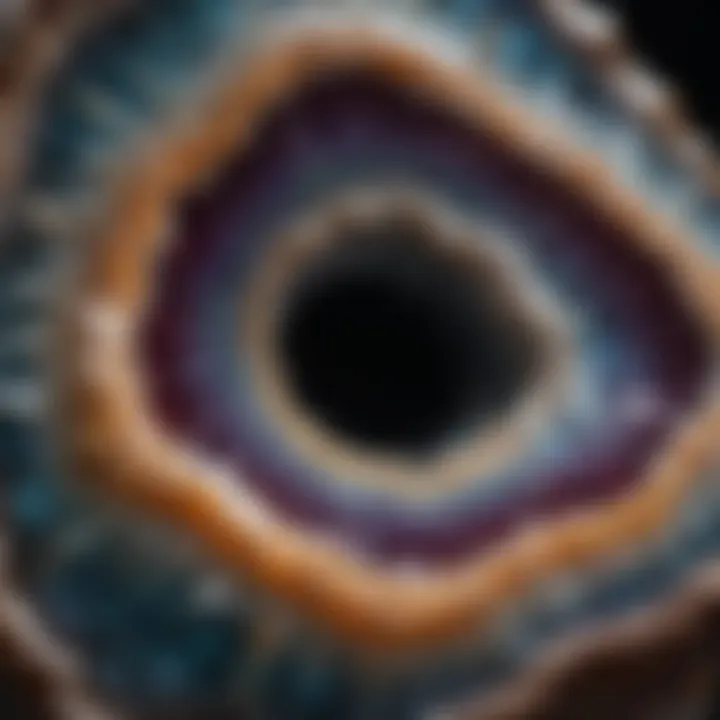
Polishing geodes is not just about bringing out their natural beauty; it is also a deep engagement with geology and craftsmanship. This process is crucial, as it transforms a rough, unassuming stone into a dazzling display piece that can captivate anyone. The journey from raw geode to a polished gem enhances its aesthetic appeal and elevates its market value, making it a worthwhile endeavor for both enthusiasts and collectors alike.
Selecting the Right Geode
Choosing the right geode sets the foundation for successful polishing. Not all geodes are created equal; some lack the interior crystal formations that make them desirable. A collector should look for geodes with promising signs, such as a well-defined outer shell and noticeable weight, often indicating a cavity filled with potential crystals. A geode that appears dull and lifeless on the outside may hide a world of wonder within, but careful selection is key. Scrutinizing the surface for cracks or imperfections is wise, as such issues may affect the end product.
Cutting Techniques
Once the right geode is selected, the cutting process is next. This step requires precision and care to avoid damaging the internal formations. Common techniques include using a diamond saw, which provides a clean cut without risking fractures. After the initial cut, considerations around the angle and depth of the slice can make all the difference in revealing stunning formations. Understanding the mineral structure is vital; for example, some minerals might be softer or harder, necessitating a tailored approach to each individual geode.
Polishing Methods
Using Abrasives
A critical aspect of the polishing process is the use of abrasives. These materials work by gradually smoothing the surface, scraping off the rough spots, and revealing the nuances of the crystals underneath. Various types of abrasives can be used, ranging from silicon carbide powders to specialized polishing compounds. The key characteristic of using abrasives is their effectiveness in making the surface smooth and shiny, which is why it's a popular choice among collectors. However, care must be taken to avoid over-polishing, which can diminish the natural beauty of the geode and compromise its structural integrity. This method is practical and, with the right skills and materials, can lead to remarkable results.
Finishing Techniques
After the fundamental polishing is done, finishing techniques come into play. This process involves finer abrasives, often used in conjunction with polishing pads or wheels. These methods are designed to bring out the highest shine possible while ensuring that the unique features of the geode are highlighted. A significant advantage of finishing techniques is the ability to achieve a glass-like sheen without losing the geode's texture and characteristic markings. It requires patience and an eye for detail, making it a rewarding endeavor that enhances the overall finish.
Tools for Polishing
Finally, the right tools can make all the difference in the quality of the finished product. Popular tools for polishing geodes include rotary tools, specialized grinding wheels, or even vibratory tumblers for those who prefer a more automated approach. Each tool serves a different purpose; while rotary tools allow for precision work, tumblers are great for batch processing multiple geodes. A notable characteristic of using specialized tools is that they can significantly reduce the time spent on polishing while ensuring a more uniform finish. Choosing the appropriate tools can enhance both the experience and the end result, making them a crucial part of the overall process.
"The allure of polished geodes lies not just in their beauty but in the meticulous journey taken to reveal it."
In essence, the process of polishing geodes comprises selecting the right specimen, employing effective cutting techniques, and utilizing appropriate polishing methods. Each step plays a vital role in bringing forth the natural splendor locked within these geological wonders, ensuring they shine brightly in any collection.
Caring for Polished Geodes
Taking care of polished geodes is key for preserving their natural charm and enhancing their visual impact. The allure that these geological marvels hold can diminish if they aren’t cared for properly. When collectors invest time and resources into acquiring a polished geode, it becomes essential to learn how to maintain its beauty over time. By paying attention to cleaning methods, maintenance routines, and display strategies, enthusiasts can ensure their pieces remain striking features in any collection.
Cleaning and Maintenance
Cleaning polished geodes goes beyond mere aesthetics; it's about protecting the gemstone from potential damage that contaminants might cause. When dirt, dust, or oils accumulate, they can cloud the surface and hide the unique formations within. Using gentle methods is advisable, such as a mild soap solution with a soft cloth or sponge. Avoid harsh chemicals and abrasive pads as they may scratch the surface or compromise the polish.
Regular maintenance not just keeps them looking good, but it also extends the lifespan of these treasures. Examine the geodes periodically for any signs of wear or damage. If you notice scratches or dull areas, it may be time for a professional polish or touch-up. Additionally, ensuring that geodes are placed in a stable environment—a place free from direct sunlight and temperature fluctuations—helps in maintaining their integrity.
Display Recommendations
Selecting how and where to display polished geodes can greatly impact their appearance and preservation. The right display contributes to the ambience of a collection and enhances the enjoyment of each piece.
Choosing Display Cases
Display cases are a key aspect of showcasing polished geodes. High-quality cases not only protect the geodes from dust and damage, but they also allow the light to bounce off their surfaces, showcasing the breathtaking colors and formations inside. Glass display cases with UV protection are especially popular as they prevent fading and deterioration.
One unique feature of these cases is their ability to offer a 360-degree view, which is beneficial for collectors who wish to admire their pieces from all angles. However, it's critical to choose cases that provide a snug fit so the geodes don’t shift or knock against each other. Some might opt for less expensive solutions like wooden shelves, but it’s essential to ensure that these do not scratch the surface of the geodes.
Lighting Considerations
Lighting plays a vital role in highlighting the beauty of polished geodes. Natural light is often the most flattering, but it can lead to fading over time. For a more controlled solution, LED lights are frequently used. They emit minimal heat and won't affect the geode’s finish. Proper lighting can accentuate colors, depth, and intricate patterns within the stone.
One notable characteristic of good lighting is its ability to transform the mood of a display. Subtle backlighting or focused lamps can turn ordinary pieces into a showcase of artistry. Collectors must be cautious, however, to avoid overly bright or direct light, which can lead to damage over time, particularly in delicate areas where the polish is thin. Finding that ideal balance ensures that the geodes maintain their brilliance for years to come.
"Proper care and display of polished geodes not only enhances their beauty but also preserves them for future appreciation."
Geodes in Culture and History


Geodes are not just geological curiosities; they hold a significant place in various cultures and throughout history. Their unique structures and dazzling interiors have captured the imaginations of people across generations. Exploring the cultural and historical contexts of geodes provides insights into their universal appeal and multifaceted significance in human society.
Cultural Significance
Symbolism in Various Cultures
Geodes have often been seen as mystical objects. In many cultures, they symbolize hidden beauty and potential, which resonates with the life journey of individuals. For instance, in some Native American traditions, the geode represents the earth's wisdom—what is hidden within can only be revealed through patience and care. The notion of discovering inner worth that parallels the scientific exploration of a geode speaks volumes about human aspirations and the search for meaning.
The key characteristic of geodes is their dual nature: plain exteriors with vibrant interiors. This stark contrast symbolizes the idea that appearances can be deceptive, a theme prevalent in spiritual and philosophical discussions across cultures. This makes geodes not only a collector's item but also a meaningful gift or talisman.
However, one must consider that with such symbolism also comes a certain weight of expectation. The beauty within a geode can sometimes lead to disappointment if one's perceptions or beliefs don't align with the physical outcome, adding a layered complexity to their interpretation.
Uses in Healing Practices
Geodes are often used in holistic and alternative healing practices. Crystals found within geodes are believed to possess energy that can promote healing, tranquility, and positive vibes. Amethyst geodes, for example, are popular for their supposed calming properties, often employed in meditative settings. Many practitioners argue that placing a polished geode in a room can enhance the energy, providing a soothing atmosphere conducive to relaxation and introspection.
What makes this practice allureing is the tactile relationship practitioners develop with the stones; the very act of holding a geode invites engagement and connection. Additionally, the aesthetic beauty of these polished minerals enhances their appeal as both a decorative item and a therapeutic tool.
Nevertheless, the use of geodes in healing can face skepticism based on the scientific rigor of such practices. Critics often point to the lack of empirical evidence supporting the therapeutic claims. Yet, the subjective experiences of individuals who have benefited from these practices cannot be dismissed altogether, representing a rich tapestry of human experience.
Historical Use of Geodes
Discovery and Exploration
The historical journey of geodes began long before modern geology. Ancient civilizations admired geodes for their unique displays and often attributed them to supernatural origins. The discovery of geodes can be traced back to ancient mineralogists who documented their findings in writings that predate recorded history.
Geodes served as objects of fascination, leading to expeditions and explorations aimed at uncovering their origins and properties. This curiosity has laid the groundwork for modern mineralogy, where the classification and examination of geodes play a vital role. The continuous interest in geodes fosters a connection between past and present, shoring up our understanding of geological processes.
Exploration also provided educational opportunities, allowing scholars to delve into Earth’s history through these rock formations, aware that each geode tells its own mineral story.
Geodes in Trade
Historically, geodes have been a part of trade routes, valued for their beauty as well as their rarity. They were often exchanged in marketplaces, symbolizing wealth and prosperity. The allure of polished geodes created a niche for them in artisanal crafts, where artisans would cut and polish these stones into eye-catching pieces, further enhancing their value.
Trade during the early years also involved fascinating practices—the journey of a geode from a rural locality to an exotic market demonstrates the value placed on natural artifacts. Not only did this trade affect local economies, but it also spread awareness of geodes and inspired collections across continents.
Today, geodes continue to captivate collectors, representing a blend of beauty, geological significance, and historical depth. They are not just rocks but time capsules that bridge ancient cultures with the modern appreciation for nature's art, echoing through the hearts of enthusiasts and collectors alike.
Geodes remind us that the most stunning treasures lie beneath the surface, waiting for those willing to explore and appreciate them.
The Future of Geode Collecting
The fascination with polished geodes is not just a trend, but rather a reflection of an enduring interest in the natural beauty and unique characteristics of these geological surprises. As more people become enamored with rock and mineral collecting, understanding the future of geode collecting becomes crucial. This future is shaped by evolving trends, community engagement, and an increased emphasis on sustainable practices.
Collecting Trends
Geode collecting is witnessing a notable tilt towards inclusivity and diversity. Traditionally dominated by seasoned collectors, the field now welcomes enthusiastic beginners seeking to cultivate their own unique collections. Online marketplaces and social media platforms have transformed how enthusiasts connect and share their finds.
- Rising Popularity of DIY Projects: Many collectors are experimenting with home polishing kits. This hands-on approach not only enriches one's understanding but also adds a personal touch to the treasured pieces.
- Community Events and Swap Meets: Local gem and mineral shows are making a comeback. These gatherings provide opportunities for collectors to trade, learn from one another, and appreciate the vast array of geodes on offer.
- Specialized Variants: There's a growing interest in rare or unique geode forms, pushing collectors to look beyond the more common quartz and amethyst varieties. This exploration often takes enthusiasts off the beaten path, leading them into lesser-known geological locales.
Embracing these trends helps to fuel a vibrant collecting culture where information and specimens flow freely, encouraging both camaraderie and competition among collectors.
Sustainability in Collection Practices
As the climate conversation deepens, so does the awareness of sustainability in geode collection. The emphasis is shifting towards ethical sourcing and responsible collecting practices. Here are some key considerations:
- Ethical Sourcing: There’s a growing concern around irresponsible mining practices that can damage local ecosystems. Collectors are becoming more selective, often prioritizing geodes that have been sourced sustainably, ensuring minimal ecological impact.
- Educational Initiatives: Many organizations and clubs are promoting conservation awareness. Workshops and articles often highlight how to collect responsibly, explaining how to respect natural habitats and understand the geological significance of each site.
- Supporting Small Businesses: Purchasing geodes from local artisans and small businesses not only keeps the money within communities but also fosters relationships that revolve around sustainable practices. Supporting these small vendors often leads to better stewardship of natural resources.
As the future of geode collecting unfolds, a delicate balance between the thrill of the hunt and the duty of care for our planet remains at the forefront of every collector’s mind. By pursuing sustainable practices, collectors ensure that future generations can enjoy these fascinating geological wonders.
"The true allure of geodes lies not only in their beauty but also in the stories they tell about the Earth’s history—let’s ensure those stories can be told for years to come."
As this community continues to grow, so too does the opportunity for enthusiasts to engage in meaningful dialogue about the importance of sustainability, ultimately shaping a future that values both the art of collecting and the preservation of natural wonders.



